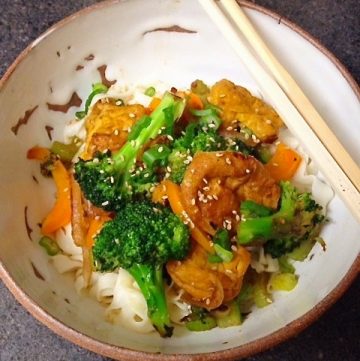- The “fragrants”: these are the ingredients that you put into the wok/pan first to flavor the oil. Some examples include minced garlic, diced onions, ginger, and hot peppers. (If you speak to more traditional Chinese cooks, such as my mother, they would say that lean pork should also fall in this category as their purpose is to flavor the oil.)
- Vegetables: I like to include at least one green vegetable (such as broccoli or bok choy) and at least a vegetable of another color. Of course, there is no “correct” combination. Just make sure that you get your vegetables in there!
- Protein: This can range from anything to beef, chicken, pork, tofu, and tempeh.
- Spices and Sauces: My go to spices are salt, granulated garlic, and five spice powder. Oyster sauce (not soy sauce) is the typical sauce that I use in my dishes. Adding soy sauce tends to be too salty, even if I’m using a low-sodium soy sauce. Oyster sauce, on the other hand, adds less salt and also has a subtle sweetness to it. If I want to jazz things up, I might use a sweet and sour sauce, satay sauce, a dash of sesame oil, or add sesame seeds on top of the dish. Pick one or more ingredients from each group, throw it in your work or pan, and that’s your dish! This was my most recent stir fry: Tofu is one of my favorite ingredients to use in stir fry dishes. We are generally familiar with the white solid block of tofu that are found in most supermarkets. However, there are plenty of other tofu varieties, and I was fortunate to be exposed to them at a young age. For my dinner, I used two different types of tofu: braised tofu (Hodo Soy Tofu Nuggets) and tofu shirataki. Traditionally, shirataki is a type of low-carb Japanese yam noodle. Recently, I discovered a tofu version and have been eating them along with my stir fries. It is very low in fat and carbs and has a chewy texture that I enjoy.
